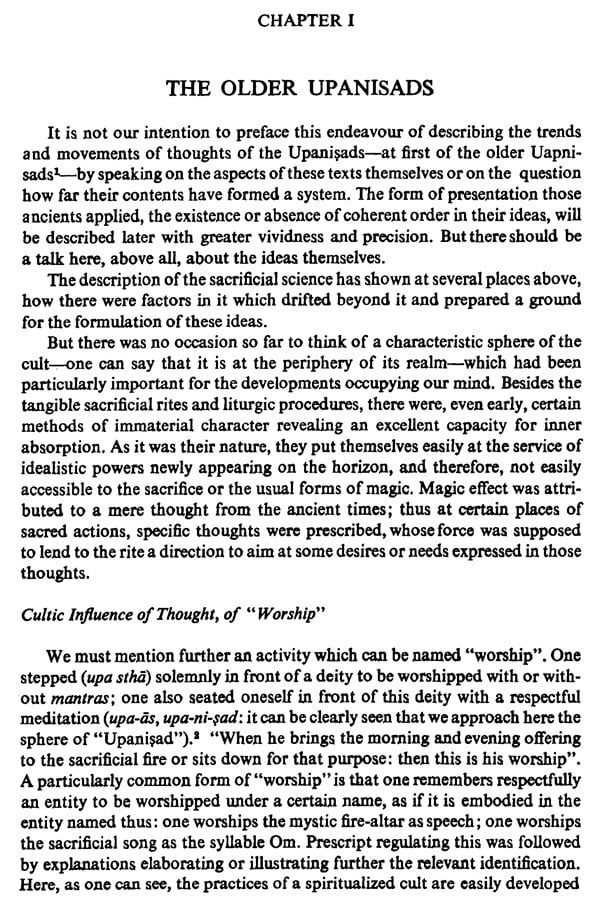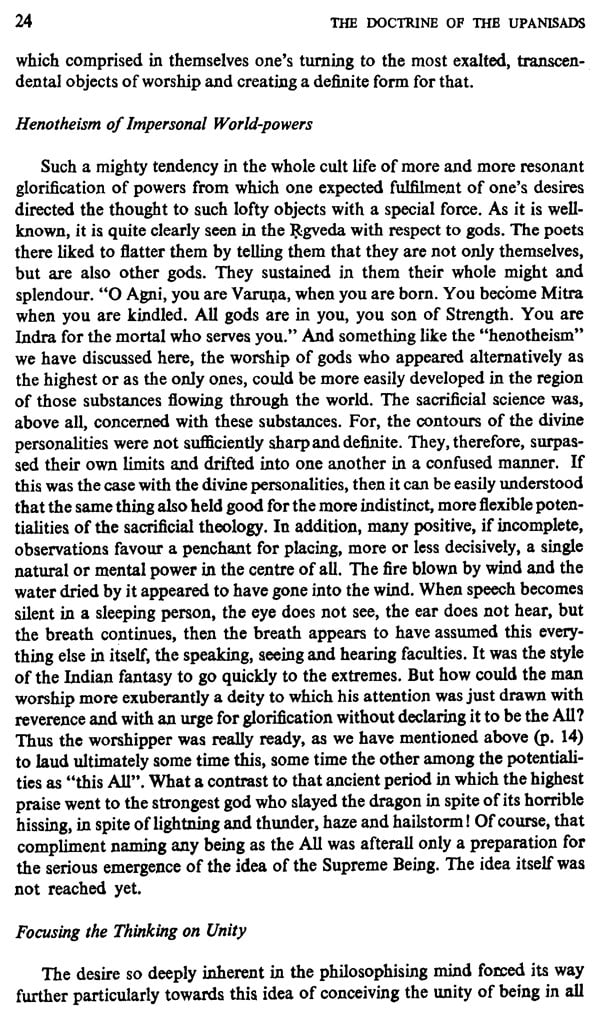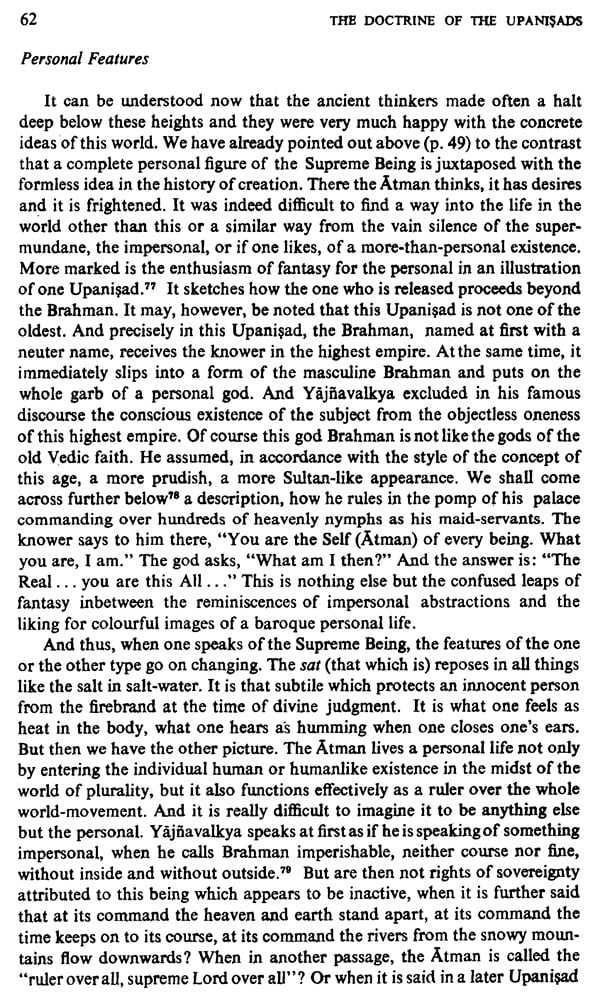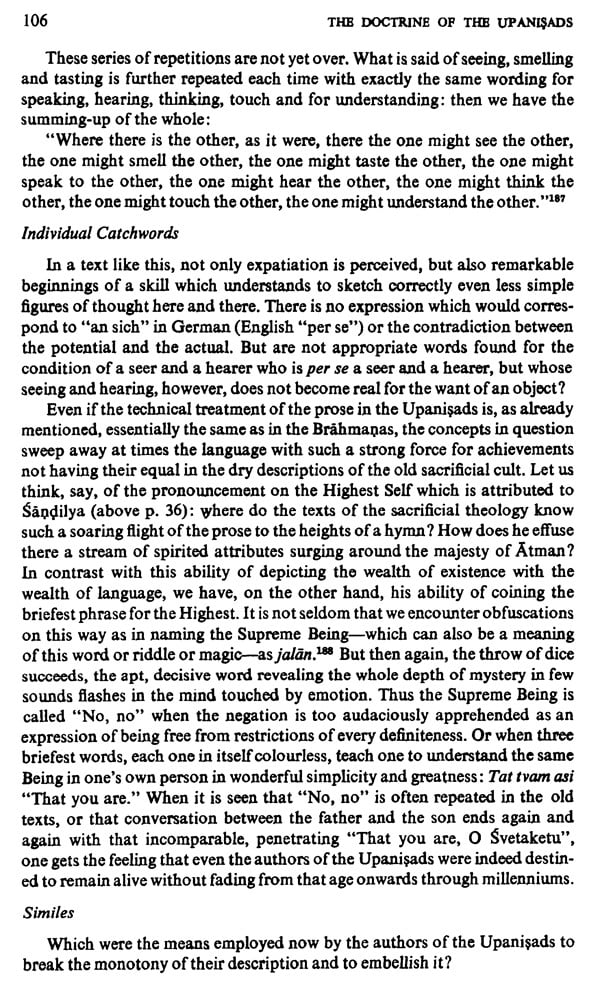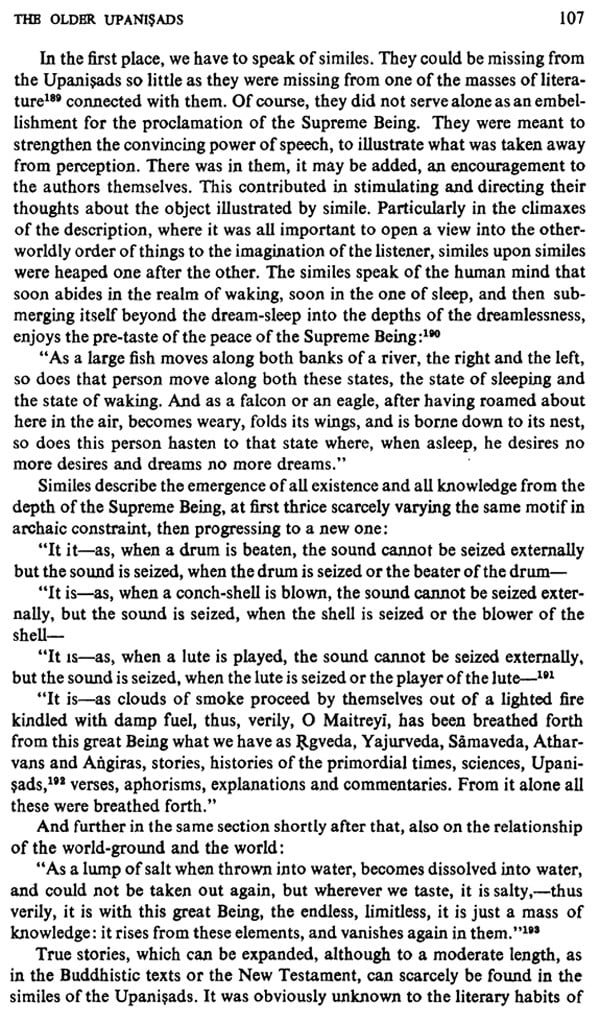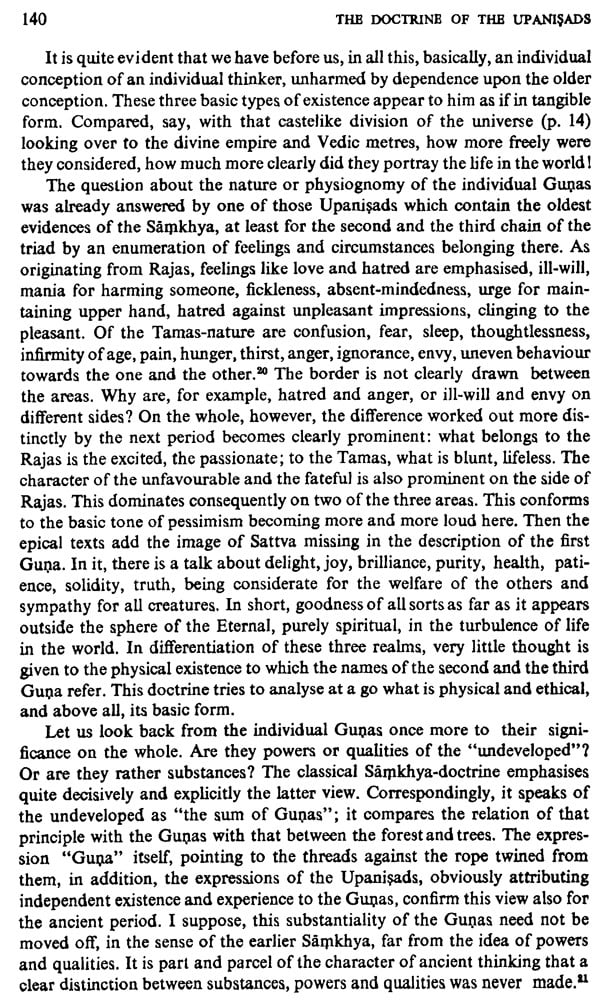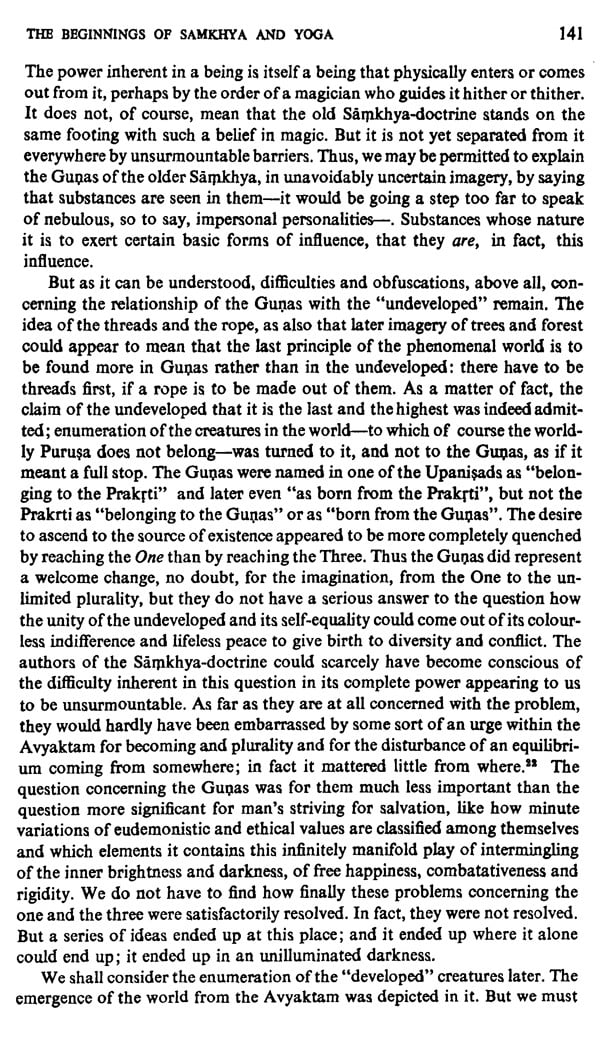
The Doctrine Of The Upanisads And The Early Buddhism
Book Specification
| Item Code: | IDC187 |
| Author: | Herman Oldenberg Translated by: Shridhar B. Shrotri |
| Publisher: | MOTILAL BANARSIDAS PUBLISHERS PVT.LTD |
| Language: | English |
| Edition: | 1997 |
| ISBN: | 9788120808300 |
| Pages: | 236 |
| Cover: | Hardcover |
| Other Details | 9.9" X 6.4" |
| Weight | 520 gm |
Book Description
About the Book:
This book was first published in 1908
Oldenberg describes in the Introduction the life and Philosophy of the Vedic Indians. In this period, a magician rose to the position of a priest in the course of development. This was the period of the Vedas and the Brahmanas.
Chapter I which discusses the older Upanisads, viz., the Brhad Aranyaka Upanisad and the Chandogya Upanisad, describes at the outset how the idea of the Supreme Being, the Unique mystic power, was conceived in the words Brahman and Atman and how these two entities merged with each other and became identical. it then discusses the doctrine of metempsychosis as evolved from the relation between the Supreme Being and the world of plurality. In this period, the magician-priest begins to become a philosopher.
Chapter II deals with later Upanisads like Kathaka Upanisad, Maitrayana Upanisad and Svetasvatara Upanisad. This period clearly reveals beginnings of the formulation of a system in the form of Samkhya Doctrine and the Yoga. Here the ultimate goal of human yearning, the salvation from suffering, becomes visible. In short, we perceive the development of thought of the Indian Philosophy from an impersonal god ( of impersonal powers) to personal god.
But interestingly, a system strongly enforcing the elements of Yoga decisively rejected theism and adhered to the pessimistic thought of Indian mysticism: the Doctrine of Buddhism. This is described in Chapter III.
About the Author:
Hermann Oldenberg (1854-1920), One of Germany's greatest Indologist, was interested in the history was equally at home in Vedic and Buddhist studies and made outstanding contributions to both subjects.
After studying at Berlin and Gottingen, he became Professor of Indology at Kiel. His first book, Buddha, Sein Leben, seine Lehre, seine Gemeinde (1881), has now become a classic. His other, equally famous books are Die Religion des Veda (1894), Die Literatur des alten Indiens (1903) and Das Mahabharata, seine Entstehung, sein INhalt, seine Form (1922).
Dr. Shridhar B. Shrotri studied German at Pune. After serving there as a Lecturer in German, he came over to Karnatak University, Dharwad in 1962 and rose there to the position of Professor of German in 1985.
His translation of Oldenberg's Die Religion des Veda into English was published in 1988.
An enquiry into the otherworldly order of things behind and beyond this world, the related problems of death and everything that comes after death has seriously occupied the minds of the Indian thinkers from very ancient times. We Endeavour to describe here a few phases, which form a natural homogeneous unit, of the history of these thoughts.
They begin where the chaos of ancient concepts of life in the world and happenings clears up. These concepts emerge mostly from the primitive past, paving the way for the powerful idea of the Brahman, the Supreme Being. Here emerges, beside the hope of joyful afterlife in the company of divine world-rulers, an outsoaring longing for departing into the peaceful quietude of eternity.
This stage of development exists in those older texts which are attributed to the Veda and which are called ‘Upanisads’.
Upanisads of later origin reveal the same thoughts in a progressive development. The-pressing questions of the relationship of the Brahman to the world appearing to the naked eye are heeded with greater attention. We find here the oldest, Vedic form of the Sãmkhya-doctrine. The philosophical contemplation of the Indians has created for the first time a system in it. When the times of the Vedic antiquity had already run their course, this system was molded into a modern form by the sophisticated science of India which had now gathered strength and knew how to describe astutely and artistically complicated structures of thoughts as in Papini’s grammar. New motifs were skillfully interwoven. In this way, the Sãmkhya-doctrine, it may be said, acquired a classical form. We shall be falling in our duty if we do not, at least, cast a glance at it.
But even before the aforesaid course of events took place in the close circles of philosopher-thinkers, there developed creations of an altogether different kind in the other environs of the same nuclei. The philosophemes gave a foundation which was strong enough to bear the burden of mighty religious creations. Buddha appeared on the scene bringing with him the solace of his doctrine to those tormented by the misery of life and the fear of death. He promised deliverance from suffering and death and an entry into the mysterious otherworld of Nirvana. It should be our Endeavour to examine the doctrine of the most ancient Buddhism in the light of its association with those works which preceded it.
Let us pause with our description for a while. It will not take in its purview the philosophical systems merging later with a movement now firmly established, nor the later religions of India, those of Visnu, Krsna or Siva. It is also not our intention to strive for perfection within the confines of our limits. We wilt rather be attempting to understand the basic dialectical motifs with which the old thinking worked, their coordination and their development. We would also like to understand the predominant mental exigencies and dispositions here. We shall further attempt to bear in mind the serious and often bizarre personalities of thinkers, who feeling strong and in a mood of renunciation, could feel that they were victors in their struggle to lift the veil from the otherworld and to overcome death.
Can one succeed “among books and papers” in a room into which looks the pale sky of the north, in cogitating upon the thoughts deliberated in the blazing heat of the Indian sun or in the downpour of the Indian rain, near sacrificial places of the villages or in the huts of the ascetics, under the wide canopy of leaves of mighty trees? Thoughts whose main features were carved out in a past, when so much was alive of the strange, shapeless phantoms of pre-historic fantasies, and so little of thoughtfully probing and plainly and ingeniously constructive sciences? Difficulties as they must have been faced by the researchers of Plato, appear here with quite a different force. A historical continuity leading to our intellectual life helping to bridge even more negligible distances, is altogether missing here. These thoughts, as if excavated from the depths of the earth, appear before us abruptly, and they are quite baffling. And suddenly, familiar features appear to be looking at us again. We should not try to conceal their faults. But at many a point, we feel like bowing our head before them in reverent silence.
Land and People Brahmana Caste
Chronological and Geographical Information
In what particular era did the developments of thinking occupying our mind begin? Of course, this cannot be definitely ascertained, since the entire older chronology of India is totally dark. Hypothetical estimation may lead us to the times around the beginning of the pre-Christian millennium.’ The geographical locale, as it can be explained from the history of origin and spread of the Vedic culture, is situated wholly in northern India: mainly in the fertile lands on the banks of the two sister-rivers, Ganga and Yamunà. But soon the movement begins to force its way to the cast beyond the confluence of these two rivers. We may have in our mind the higher classes of Aryan Indians, assumed to have immigrated from Iran—perhaps a millennium before—as yet not being too deeply affected by miscegenation with the despised dark aborigines of the land. Even today, Brahmanas of pure or almost pure fair type have continued to exist. Thus, with respect to racial character, the Brahmanas of that age still resembled their relatives: the Iranian priests who experienced perhaps at the same time the Zoroastrian reform and yet the different between the Indian intellectual and spiritual character and that of the Iranians was obviously sufficiently pronounced. The nature the climate of Indian their easy domination over the aboriginal people and the absence of great historical battles spread around the Brahmanas an atmosphere of undisturbed peace. This helped the blossoming of a penchant for contemplation cultivation of complicated knowledge for play of unrestrained imagination which indulged again and again in the dreadful and the monstrous.
| Acknowledgements | v |
| Introduction | 1 |
| Enquiry into the otherworldly order of things in the older Upanisads the later ones (Samkhya) and Buddhism | 1 |
| Land and people Brahmana caste | 2 |
| Chronological and geographical Information 2. the race caste system 3. A Brahman pupil his relationship to his Knowledge 4. Brahmana’s Pride in his knowledge 5 | |
| Science of Sacrifice | 6 |
| Pre-Historical Background 6. The Vedic Gods 7. Personal and Impersonal Entities 8. The Brahmana texts 9. The Magic property in the Sacrifice 10. Powers in Nature in Human personalities in the Veda 11. Style of thinking focused on these powers 12. Regulations Among those powers 13. | |
| Death and the otherworld | 15 |
| The Problem of the otherworld Intermingling of older and newer elements 15. the Re-death 16. Karman 17. Immortality Deliverance 18. | |
| References | 20 |
|
|
|
| The Older Upanisads | 23 |
| Cultic Influence of thought of worship 23. Henotheism of Impersonal world powers 24. focusing the thinking on Unity 24. Focusing the desires on Unity 26. Mysticism 27. | |
| The Brahman | 28 |
| Different Names of the supreme Being 28. The Brahman its ancient concept 29. Brahman and Ksatra 30. Related concepts outside India 30. elevation of Brahman to the highest esteem 31. | |
| The Atman | 33 |
| Atman and Breath 33. Atman the self 34. the Universal atman 34. | |
| Brahman and Atman Made Identical | 35 |
| The Prose Hymn of the Sandilya 36 | |
| The Absolute and its relation to the world | 37 |
| The Problem of Unity and Plurality 37. The One All animating 38. Positive and Negative Expressions the No” no 39. the one all animating 41 infinitely big and infinitely small 44. the inner driving force origin of values 46. The world creator 48. Remaining also in the reality of many besides the one 51. Identity of the one and the many 52. plurality explained as appearance 54. | |
| The Absolute in itself personality or impersonality | 58 |
| The Absolute not merging with the world 58. uncertainty about the alternatives between personality and impersonality 60. impersonal features 61. personal features 62 | |
| Metempsychosis Karman | 63 |
| Different forms of the doctrine of Metempsychosis 63. The Karman moral Retribution 65. | 35 |
| Merit of Existence | 68 |
| The world Judges as pervaded by Brahman 68. the world Judged as different from Brahman pessimism 69. Death and the other Evils 69. the character of the Indian Pessimism 73. | |
| Deliverance | 74 |
| Relationship between the universal and the individual self 74. deliverance through knowledge and note through works 76. can the absolute be known? 78. Desirelessness 79. the nature of the process of Deliverance 80. the Earthly existence of the redeemed Sramanahood 81. The Beginnings of Yoga 83. Egoism in the Ideal of Deliverance 84. death of the one who is redeemed 84. doubts about the character of hope in immortality 86. | |
| The Literary form of the Upanisads | 87 |
| Plurality of Upanisads Their affiliation to the forest texts 87. Composers list of teachers. Their Distribution among Vedic Schools 88. Consisting of Brief text pieces 89. Larger compositions 90. Upanisad in its narrower sense(text of worship) 91. Dialogues 94. Their External form participating persons 94. emergence of Princes 97. Beings which are not human beings 98. Portrayal of the emerging thinkers 99. Technique of the dialogue 100. The nature of this prose 104. Individual catchworks 106. Similes 106. riddles 108 verses 109. | |
| In Retrospect | 111 |
| Upanisads between the older and the later period 111. The Supreme Being and the world. Significance of their antithesis 111. In Relation to Kant and Christian Mysticism 113. Brahmanahood and Sramanahood 116 | |
| References | 117 |
|
|
|
| The Later Upanisads and the Beginnings of Samkhya and yoga | 131 |
| The Beginnings of Samkhya System | 134 |
| Relationship with the older speculation in general 134. The Name Samkhya 134. Kapila and the other philosophers 135. The Upanisads and the epic as sources 135. Dualism 137. The material fundamental principle (purusa) 143. Evolution of prakrti 144. Purusa and Prakrti 149. Obligations of the Purusa 152. Deliverance 154. Retrospect and prospects for further Development 156. Materialization of Intellectual Happening 157. Materialization of suffering 158. Plurality of Purusa 160. The Deliverance in the later form of the doctrine Prakrti Doing her work for the purusa 162 | |
| The Yoga | 164 |
| The Beginnings of Yoga 164. Discipline of the Breath body postures mastering the senses 165. Maeditations 167. fruits of yoga Miraculous powers 168. Deliverance 169. Theoretical principles relation to samkhya 170. Nirvana 171 Position of the yoga in the spiritual development of India 172. | |
| A personal god the svetasvatara Upanisad | 173 |
| References | 178 |
|
|
|
| The Early Buddhism | 185 |
| Brahminism and Buddhism 185. Geographical Relation of Buddhism to the Upanisads 185. Chronological relation to the older Upanisads historical advances 186. Chronological relation to the later Upanisads 189. Buddha’s Environment Sophism Pyrrhonism 190. Buddha Rejects purely theoretical knowledge 191. Influence of Samkhyas Buddhistic Evidences on it 192. Are there inner correlations 193. Buddhistic Dualism between what is conformed and what is not conformed 193. position with respect to Atman 195. Dominance of Causality in the world 196. Super mundane being 197. Substrata 202 Relationship between the world and the super mundane 203. Samkhya as a preliminary stage of this Buddhistic Dualism 204. Relationship between Buddhism and Yoga 207. Independent creations of Buddhism in the realm of the doctrine 213. In the realm of religious life 215. The figure of Buddha 216 | |
| References | 219 |
| Index | 223 |
Of Related Interest:
Early Buddhism and the Bhagavadgita
